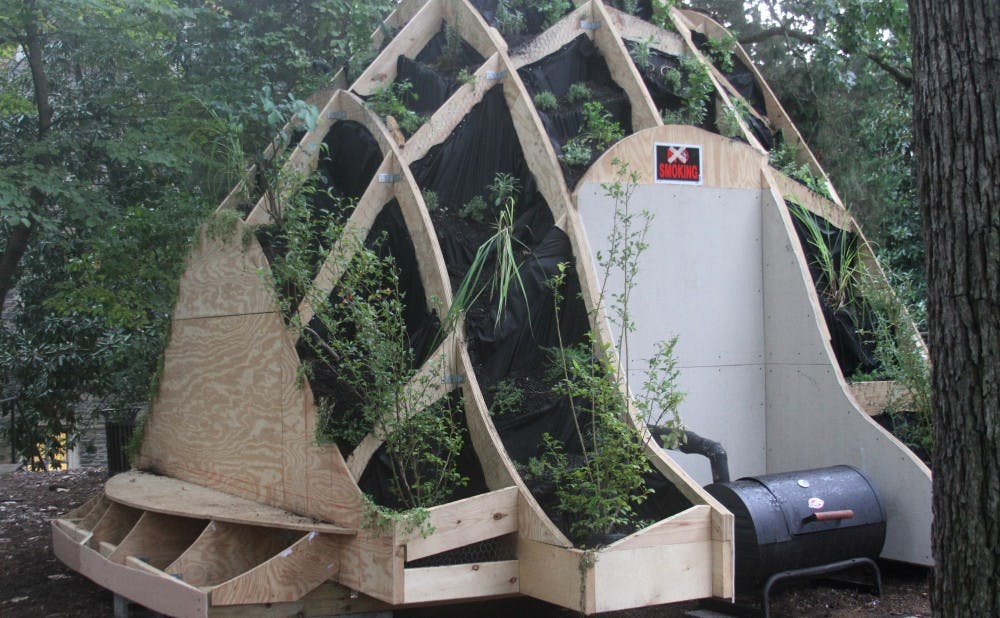Foodies with a taste for the freakish are bringing a unique culinary experience to campus.
The construction of a temporary wooden smokehouse outside the entrance of the Allen Building is part of Subnature and Culinary Culture—a trans-disciplinary semester project examining food, culture, and society. Funded by a grant from Humanities Writ Large, the project aims to create a dialogue that enables both science and humanities classes to riff on the concept of the subnature. The term refers to the strange and bizarre qualities of architecture—darkness, dankness, debris, stagnancy—that are typically shunned in favor of qualities such as light, airiness, symmetry, order and centrality.
“As soon as we create forms of normality for spaces we should live in, we marginalize other subnatures,” said Thomas Parker, Humanities Writ Large visiting faculty fellow and assistant professor of French and francophone studies at Vassar College. “It throws people into the margins, people who don’t have access.”
Parker said what interests the project team is how these subnatures form at different times in different locations, and how these same qualities exist in food. Students can better understand the realms of the sciences and humanities by studying food and food choices, he added.
“We are taking a paradigm and superimposing it on food,” he said. “What can it tell us about how food qualities are essentialized?”
The project will focus on a variety of foods, textures and smells that most Americans view as disgusting or abnormal. Such foods include insects, pig cheek and “stinky” cheeses.
“Two thirds of the world eat grasshoppers— they’re a great efficient source of protein and ecological," Parker said. "Who says insects are gross? We say that, but most people don’t.”
Parker aims to enable students to see food in a new way, rather than just as sustenance or pleasure.
“We want students from the sciences to sit in an Italian class on the subnature aspect of italian worm cheese and to say that I understand the biology, but didn't understand the cultural importance," he said. "We want them to say, ‘I can now see an intersection, giving me more scope and context—maybe I like it because it’s probiotic.'”
Earlier this week, Parker and his colleagues presented their plans for the upcoming month at the John Hope Franklin Center, where smoked meringues from the smokehouse were served. Future events will include a lunch with David Gissen—the theorist and historian who coined the term subnature—as well as a meal at Marketplace featuring samples from the smokehouse and an on-campus hog roast.
Representatives from Copenhagen’s Nordic Food Lab and North Carolina Chefs will prepare a dinner on Oct. 2. The food lab operates in collaboration with Noma, a gastronomic restaurant in Copenhagen recently voted the best in the world by Restaurant magazine.
A number of students and faculty are involved with the initiative, including Ashley Young, a fourth-year Ph.D. candidate in history who studies food's relationship to identity, migration and economic empowerment. She will present her work on New Orleans food culture at the David Gissen lunch. Discussion will focus on how vending street food allowed 19th-century slaves to buy their freedom and immigrants to develop new identities.
“The thing I’m most interested in is making the critical study of food culture more present in the Duke community,” Young said. “Everyone is a foodie nowadays—we all Instagram our food. People realize that food is important to identity, how we think about ourselves and connect with people.”
She explained that by understanding the patterns of food systems, solutions can be found for hunger and food security.
Gissen and Young’s lunch will feature calas, a rice ball prepared the night before by mixing overcooked, mushy rice with wild yeast and then cooked in a batter the next morning, deep-fried in lard, and coated in powdered sugar. The dish—believed to have been brought to New Orleans from West Africa—will be cooked and fried on site by Phoebe Lawless of Scratch Bakery. Smoked pigeon po’boy sandwiches will also be served.
The calas and po’boys will be served in paper cones and sandwich wrappers printed with images of street food vendors. Young and Jennifer Stratton—a master's of fine arts candidate in experimental documentary arts and lab manager for the Ph.D. Lab in Digital Knowledge— will ask people to write their reactions to the street foods onto the used wrappers. Young and Stratton then plan to sew the wrappers into a quilt, incorporating historic maps into the tapestry.
The tapestry, to be titled “Taste Terroir Tapestries”, will be installed at the Jameson Gallery on East Campus and then permanently at the Southern Food and Beverage Museum in New Orleans. The title is based on the French term “goût du terroir,” or “taste of place,” meaning the distinct flavors imprinted on a food or wine by its physical origin. Food identified with terroir was originally associated with the filth of the French provinces, but has since been re-appropriated as an instrument for regional pride and identity.
Get The Chronicle straight to your inbox
Signup for our weekly newsletter. Cancel at any time.

